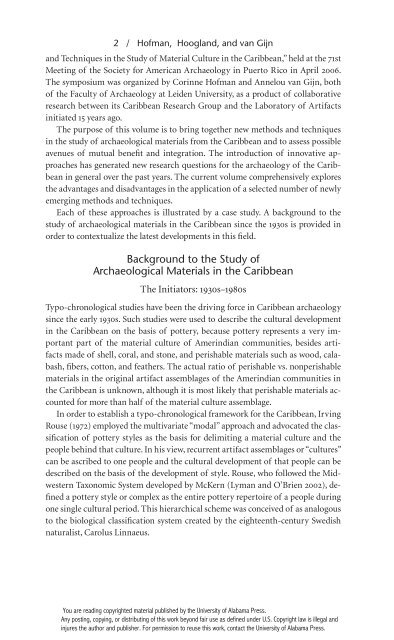Crossing the Borders: New Methods and Techniques in the Study of Archaeological Materials from the Caribbean
by Corrine L. Hoffman, et. al.
by Corrine L. Hoffman, et. al.
Create successful ePaper yourself
Turn your PDF publications into a flip-book with our unique Google optimized e-Paper software.
2 / H<strong>of</strong>man, Hoogl<strong>and</strong>, <strong>and</strong> van Gijn<br />
<strong>and</strong> <strong>Techniques</strong> <strong>in</strong> <strong>the</strong> <strong>Study</strong> <strong>of</strong> Material Culture <strong>in</strong> <strong>the</strong> <strong>Caribbean</strong>,” held at <strong>the</strong> 71st<br />
Meet<strong>in</strong>g <strong>of</strong> <strong>the</strong> Society for American Archaeology <strong>in</strong> Puerto Rico <strong>in</strong> April 2006.<br />
The symposium was organized by Cor<strong>in</strong>ne H<strong>of</strong>man <strong>and</strong> Annelou van Gijn, both<br />
<strong>of</strong> <strong>the</strong> Faculty <strong>of</strong> Archaeology at Leiden University, as a product <strong>of</strong> collaborative<br />
research between its <strong>Caribbean</strong> Research Group <strong>and</strong> <strong>the</strong> Laboratory <strong>of</strong> Artifacts<br />
<strong>in</strong>itiated 15 years ago.<br />
The purpose <strong>of</strong> this volume is to br<strong>in</strong>g toge<strong>the</strong>r new methods <strong>and</strong> techniques<br />
<strong>in</strong> <strong>the</strong> study <strong>of</strong> archaeological materials <strong>from</strong> <strong>the</strong> <strong>Caribbean</strong> <strong>and</strong> to assess possible<br />
avenues <strong>of</strong> mutual benefit <strong>and</strong> <strong>in</strong>tegration. The <strong>in</strong>troduction <strong>of</strong> <strong>in</strong>novative approaches<br />
has generated new research questions for <strong>the</strong> archaeology <strong>of</strong> <strong>the</strong> <strong>Caribbean</strong><br />
<strong>in</strong> general over <strong>the</strong> past years. The current volume comprehensively explores<br />
<strong>the</strong> advantages <strong>and</strong> disadvantages <strong>in</strong> <strong>the</strong> application <strong>of</strong> a selected number <strong>of</strong> newly<br />
emerg<strong>in</strong>g methods <strong>and</strong> techniques.<br />
Each <strong>of</strong> <strong>the</strong>se approaches is illustrated by a case study. A background to <strong>the</strong><br />
study <strong>of</strong> archaeological materials <strong>in</strong> <strong>the</strong> <strong>Caribbean</strong> s<strong>in</strong>ce <strong>the</strong> 1930s is provided <strong>in</strong><br />
order to contextualize <strong>the</strong> latest developments <strong>in</strong> this field.<br />
Background to <strong>the</strong> <strong>Study</strong> <strong>of</strong><br />
<strong>Archaeological</strong> <strong>Materials</strong> <strong>in</strong> <strong>the</strong> <strong>Caribbean</strong><br />
The Initiators: 1930s–1980s<br />
Typo- chronological studies have been <strong>the</strong> driv<strong>in</strong>g force <strong>in</strong> <strong>Caribbean</strong> archaeology<br />
s<strong>in</strong>ce <strong>the</strong> early 1930s. Such studies were used to describe <strong>the</strong> cultural development<br />
<strong>in</strong> <strong>the</strong> <strong>Caribbean</strong> on <strong>the</strong> basis <strong>of</strong> pottery, because pottery represents a very important<br />
part <strong>of</strong> <strong>the</strong> material culture <strong>of</strong> Amer<strong>in</strong>dian communities, besides artifacts<br />
made <strong>of</strong> shell, coral, <strong>and</strong> stone, <strong>and</strong> perishable materials such as wood, calabash,<br />
fibers, cotton, <strong>and</strong> fea<strong>the</strong>rs. The actual ratio <strong>of</strong> perishable vs. nonperishable<br />
materials <strong>in</strong> <strong>the</strong> orig<strong>in</strong>al artifact assemblages <strong>of</strong> <strong>the</strong> Amer<strong>in</strong>dian communities <strong>in</strong><br />
<strong>the</strong> <strong>Caribbean</strong> is unknown, although it is most likely that perishable materials accounted<br />
for more than half <strong>of</strong> <strong>the</strong> material culture assemblage.<br />
In order to establish a typo- chronological framework for <strong>the</strong> <strong>Caribbean</strong>, Irv<strong>in</strong>g<br />
Rouse (1972) employed <strong>the</strong> multivariate “modal” approach <strong>and</strong> advocated <strong>the</strong> classification<br />
<strong>of</strong> pottery styles as <strong>the</strong> basis for delimit<strong>in</strong>g a material culture <strong>and</strong> <strong>the</strong><br />
people beh<strong>in</strong>d that culture. In his view, recurrent artifact assemblages or “cultures”<br />
can be ascribed to one people <strong>and</strong> <strong>the</strong> cultural development <strong>of</strong> that people can be<br />
described on <strong>the</strong> basis <strong>of</strong> <strong>the</strong> development <strong>of</strong> style. Rouse, who followed <strong>the</strong> Midwestern<br />
Taxonomic System developed by McKern (Lyman <strong>and</strong> O’Brien 2002), def<strong>in</strong>ed<br />
a pottery style or complex as <strong>the</strong> entire pottery repertoire <strong>of</strong> a people dur<strong>in</strong>g<br />
one s<strong>in</strong>gle cultural period. This hierarchical scheme was conceived <strong>of</strong> as analogous<br />
to <strong>the</strong> biological classification system created by <strong>the</strong> eighteenth- century Swedish<br />
naturalist, Carolus L<strong>in</strong>naeus.<br />
You are read<strong>in</strong>g copyrighted material published by <strong>the</strong> University <strong>of</strong> Alabama Press.<br />
Any post<strong>in</strong>g, copy<strong>in</strong>g, or distribut<strong>in</strong>g <strong>of</strong> this work beyond fair use as def<strong>in</strong>ed under U.S. Copyright law is illegal <strong>and</strong><br />
<strong>in</strong>jures <strong>the</strong> author <strong>and</strong> publisher. For permission to reuse this work, contact <strong>the</strong> University <strong>of</strong> Alabama Press.


















